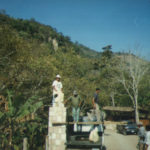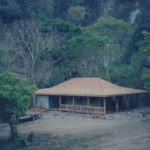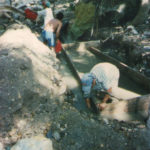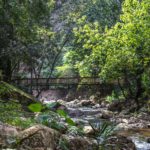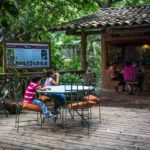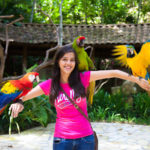Our story
The story of Macaw Mountain bird park and nature reserve actually began on Roatan, in the Bay Islands. It was there that an American lady, Mandy Wagner, started caring for unwanted parrots and macaws during the 1980’s, amassing a group of 30 birds by the mid 1990’s. Many of these parrots had been left behind or donated by foreign residents when they had enough of “paradise” and returned to their home country. Eventually Ms. Wagner herself returned to the U.S. and care of her birds passed to Lloyd Davidson who was running a fishing business in Roatan at the time. This is how Lloyd accidentally became the “Bird Man of Roatan”.
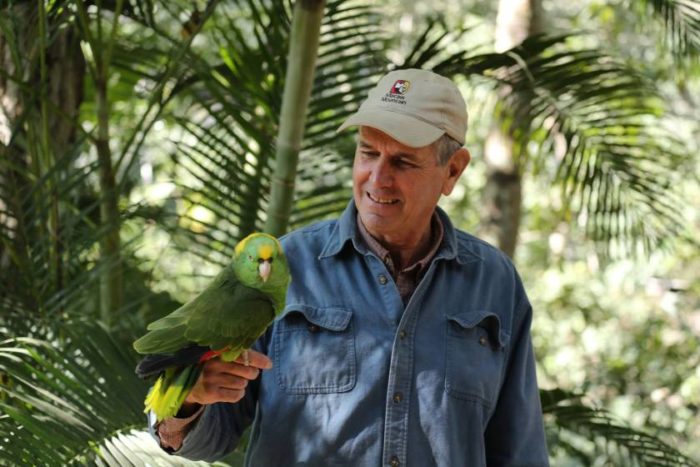
LLoyd Davidson, “Bird Man of Roatan” and founder of Macaw Mountain
His taking-over of the collection, about 35 birds in total, coincided with an increase in the number of expats moving to Roatan, many of whom at some point during their stay acquired a parrot, parakeet or macaw as part of their island life. This eventually led to a sharp increase in the number of unwanted parrots and Lloyd’s collection rapidly grew to almost 80 birds.
Keeping this many birds in good living conditions became both time consuming and expensive, so the first bird park was founded on rented property near the beach in Sandy Bay. Once a dream of Ms. Wagner’s, this had now become a necessity to support the growing operation financially. And since macaws can live up to a 100 years in captivity, it was not a short-term problem either. But the hope was that the growing tourism from cruise ships visiting the island would provide enough visitor revenue to support the park’s feathered residents in the long run.
The Roatan Bird Park was in operation for 5 years and proved to be a useful testing ground for concepts later utilized here at Macaw Mountain. Much was learned about the bird’s diets, their interactions and behavior, aviary size and construction, plants that would do well in the presence of the birds, and even nesting requirements. The first scarlet macaw babies were born and successfully raised and became strong flyers on Roatan.
Gradually the island park began to pay the bills but the Bird Man was ready for a change. A visit to Copán Ruinas in 1998 had him convinced that this area was a perfect environment for the birds and land was more affordable than in the Bay Islands. Within a year construction work began under the direction of Lloyd’s partner in the fishing business, Capt. Pat Merritt, Progress was slow but steady as efforts were made to limit impact to the natural beauty of the stream-fed valley on the property. In July 2001 a plane was chartered to fly 90 birds from Roatan directly to Tablones, a dirt strip just across the border in Guatemala. After a 5 month adjustment period to allow the birds to cope with the sudden move from the beach to the mountains, Macaw Mountain Bird Park and Nature Reserve was officially opened to the public in December 2001.
The park in Copán Ruinas, during its construction and nowadays
Our mission
Since the early years in Roatan, our mission has evolved considerably.
Care for unwanted captive birds
In Roatan the initial mission was simply to care for unwanted captive birds, mostly coming from the island’s expatriate community. Many lessons were learned and as the number of birds increased the concept of a park to support their care developed.
Educate people
As visitors came to the island park it was obvious that the parrots, macaws, and toucans left a mark with their stunning colors and fascinating behavior. We knew that a large number of birds were kept throughout the region, many on poor diets and in tiny cages.
So we began to use our birds to educate the people and make the case for their protection. We are convinced that this approach had the desired positive effect, and even today most of our donations come from people who have visited our park and from friends they have spoken with.
Restore bird populations
Macaw Mountain’s latest mission extension is one of outreach. We are increasingly involved in efforts to restore free-flying populations of macaws and parrots to the Copán valley.
A visit to the park in 2010 by Dr. Jamie Gilardi of the World Parrot Trust resulted in a group effort under the banner “Guaras en Libertad, La Belleza Regresa” (“Macaws in freedom, beauty returns”) to reintroduce a flock at the Copán Archaeological Park. The first group of our macaws was liberated there in April 2011 and supplemented the 14 birds already resident there.
With our fourth liberation in June 2016 and with chicks born at the site in recent years ,we have now have more than 40 scarlet macaws flying above the ruins and about the valley. Macaw Mountain provides the infrastructure, human resources, monitoring, and much of the financing for this important project.


